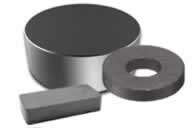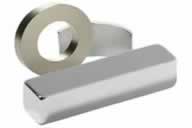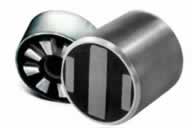Intro to Magnets
 Magnets can be natural and manmade. Natural magnets are found in the earth and are rich in an iron mineral called magnetite. Man-made magnets are developed in a lab by taking metallic alloys and processing them to align the charge.
Magnets can be natural and manmade. Natural magnets are found in the earth and are rich in an iron mineral called magnetite. Man-made magnets are developed in a lab by taking metallic alloys and processing them to align the charge.
There are four main kinds of magnets:
- Permanent Magnets
- Temporary Magnets
- Electromagnets
- Superconductors
Within the four different kinds of magnets there are also different grades/types of magnets.
Permanent Magnets
Permanent magnets are used in everyday life. Once permanent magnets have been magnetized they retain their magnetism to a certain degree. Magnets are made up of different atoms and molecules that are ferromagnetic material. These atoms and molecules have a magnetic field that allows them to reinforce each other. Nickel, cobalt, steel, and iron are a few of the ferromagnetic materials that have strong magnetic properties.
Permanent magnets do vary in strength. Some are very hard to be demagnetized but can still be damaged. Magnetic attraction of the atoms can become damaged if other magnets and magnetic material is close proximity. Extreme weather conditions of highs and lows can also demagnetize the magnets. Although their appearance is solid, handling them with care is extremely important. Dropping, hammering, jarring and using force on the magnet can also demagnetize the material.
Permanent magnets come in many different shapes and sizes and can be made into various shapes. They can also be flexible with different degrees of thickness and lengths. Flexible magnetic strips or sheets are made of a ferromagnetic powder mixed with a polymer bonding.These high energy strips resist demagnetization, and will not chip, crack, or shatter. Flexible magnetic material can be magnetized with two or more poles along the length of the face, creating concentrated strength on the face of the magnet.
There are 4 main types or subcategories of permanent magnets.
Neodymium Iron Boron - NdFeB- NIB - Neo
 Neodymium Iron Boron magnets are a type of rare earth magnetic material. These magnets are known by a few different names. It can be see as NdFeB because it is made from an alloy of the three different materials. The Nd is the symbol for the chemical element Neodymium, Fe is the symbol for the chemical element Iron and B is the symbol for the chemical element Boron. NIB and Neo are just abbreviations, NIB standing for Neodymium Iron Boron and Neo just short for Neodymium.
Neodymium Iron Boron magnets are a type of rare earth magnetic material. These magnets are known by a few different names. It can be see as NdFeB because it is made from an alloy of the three different materials. The Nd is the symbol for the chemical element Neodymium, Fe is the symbol for the chemical element Iron and B is the symbol for the chemical element Boron. NIB and Neo are just abbreviations, NIB standing for Neodymium Iron Boron and Neo just short for Neodymium.
These magnets are high energy products and very magnetically strong that are hard to demagnetize. They can be made in very compact and small sizes because they have a high energy level. Neo magnets are brittle and corrosive because Neodymium reacts to oxygen and oxidizes if untreated. That's why a protective coating is needed. The coating is so thin that it doesn't significantly impact the force of the magnet.
Neodymium magnets are used in a wide variety of applications.From computer hard disks, and headphones to industrial applications like generators, motors and wind turbines. Although they are very strong, light, and affordable they are neodymium based so when exposed to low temperatures they can lose their magnetism.
To find out more details about these magnets cheek out our neodymium guide.Samarium Cobalt - SmCo
Samarium Cobalt or SmCo which stands for its chemical elements, are also in the family of rare earth magnets. They are very similar to the neo magnets as far as strength but the neo magnet is stronger. There are two different series of SmCo magnets that are based on their product energy rangel. The first being Sm1Co5 or Series 1:5 and the second Sm2Co17 or Series 2:17. Sm1Co5 has and energy product range of 15 to 22 MGOe and Sm2Co17 has an energy product range of 22 to 32 MGOe.
The big difference, and depending on the grade, they have little or no iron which means they are very resistant to corrosion unlike the neo magnets that are usually coated. The other big difference is they can hold their magnetic properties across a much larger range of temperature. Which means that in high and low temperatures they are very resistant to demagnetisation. Although they do stand up against corrosion they are brittle and can chip easily.
The resistance to temperature and corrosion makes the samarium cobalt magnets a great fit for applications that work in high temperature and humid conditions like motors and sensors and are used frequently in the automotive, marine, aerospace and medical industries.
Alnico
 Alnico is made from alloys of Aluminum, Nickel, and Cobalt. In fact it gets its name from the first 2 letters of each of the alloys. Unlike the other two rare earth magnets Alnico can be demagnetized easily when they are not handled correctly. Although they have a good range of temperature stability and high energy often times they are replaced in many application with rare earth magnets or ceramic.
Alnico is made from alloys of Aluminum, Nickel, and Cobalt. In fact it gets its name from the first 2 letters of each of the alloys. Unlike the other two rare earth magnets Alnico can be demagnetized easily when they are not handled correctly. Although they have a good range of temperature stability and high energy often times they are replaced in many application with rare earth magnets or ceramic.
There are two different ways the Alnico magnets is manufactured. One is cast Alnico, and this allows the magnet material to be formed into many different shapes. Casting also gives a higher energy product that is often used in sensing devices, meters, and many other instruments. Sintering Alnicos makes the magnets have a stronger mechanical traits but the negative it lowers its magnetism.
To find out more details about Alnico magnets cheek out our alnico magnet guide.
Ceramic or Ferrite
 Ceramic magnets are also referred to as Ferrite magnets. The ceramic magnet is a nonmetallic compound of pure grades of iron oxide and strontium carbonate, and small quantities of other metal oxides. These magnets are very brittle and chip and crack very easily. Although they are lower in energy level they have a pretty good balance of magnetic force and not easily demagnetized. They are one of the most used magnets today.
Ceramic magnets are also referred to as Ferrite magnets. The ceramic magnet is a nonmetallic compound of pure grades of iron oxide and strontium carbonate, and small quantities of other metal oxides. These magnets are very brittle and chip and crack very easily. Although they are lower in energy level they have a pretty good balance of magnetic force and not easily demagnetized. They are one of the most used magnets today.
There are two different ways to make these magnets by sintering or pressing. The compound is calcined, wet ball milled to a fine particle size, binders are added, then the mix is compacted in a press. The compacted shapes are fired at high temperatures in kilns to a closely controlled temperature cycle. Upon cooling, the parts are diamond sawed and diamond wheel ground to specifications.
To find out more details about Ceramic magnets cheek out our ceramic magnet guide.
Temporary Magnets
Temporary magnets are exactly what their name implies, temporary. The material, mostly soft iron or iron alloys, only works as a magnet when they are in the presence of a strong magnetic field. As soon as they are no longer in a magnetic field they lose their magnetic force. An example of a temporary magnet would be nails. When they come into contact with a nail sweeper magnet their magnetic force engages and they cling to the nail sweeper. Once they are taken off the nail sweeper they lose their magnetic force.
Electromagnets
Electromagnets need to have electricity flowing through it for it to become magnetic. The strength of these magnets depends on the strength of the electric current that runs through it. The way it works is a wire is tightly wound in a coil, often with a iron core, and once an electric current runs through the coil it magnetizes and acts as a permanent magnet. Once the current is gone so is it magnetism. Speakers, computers, radios, and even televisions all use electromagnets.
Superconductors
Superconductors are also made from a coil of wire like electromagnets. Unlike the electromagnets the special metal alloys the coils are made of don’t have a metal core. These are the strongest magnets out of all of them. They produce a extremely intense magnetic field but they wire must be cooled to a certain temperature in order for the special metal alloys to become superconductors. These magnets use hardly any power because the power is only needed for the equipment that cools the coils. These are used in MRI machines, particle accelerators, and mass spectrometers.
Are you looking for magnets?
Submit an RFQ now!
